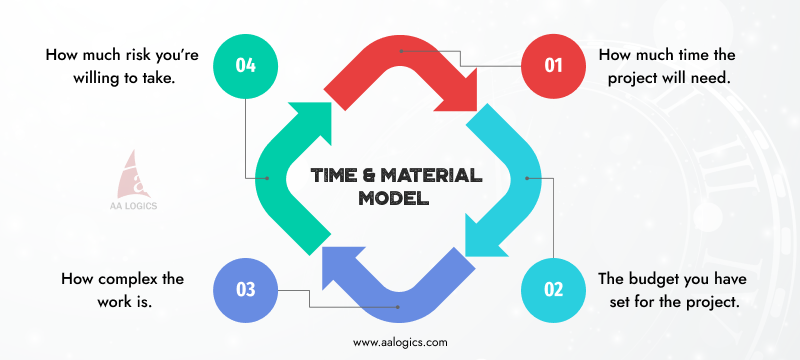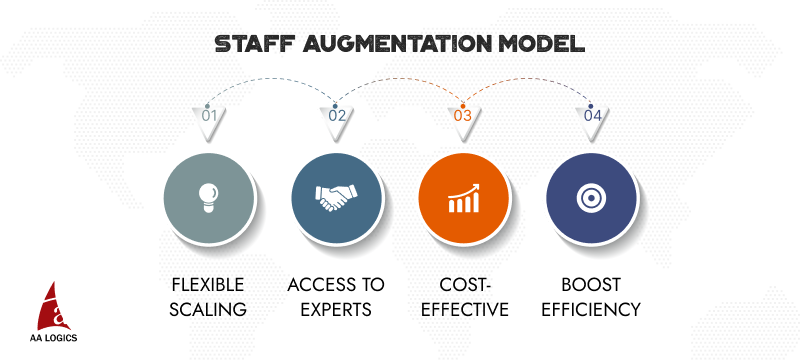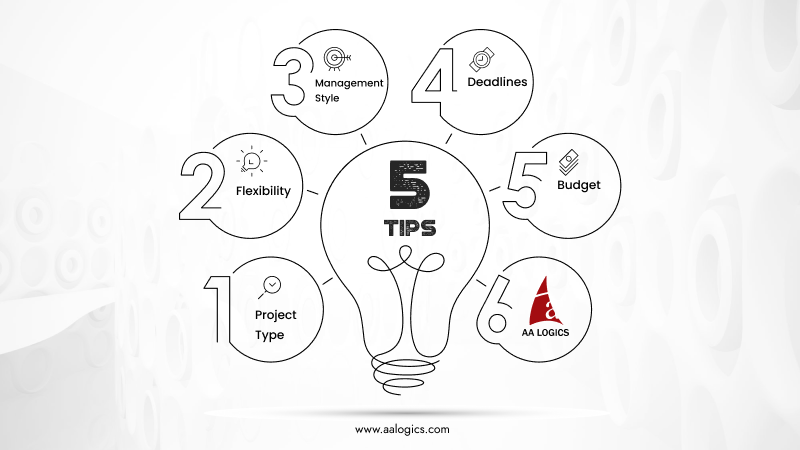Choosing the right engagement model is crucial for the success of your software development project, as it impacts everything from construction and utilization to costs and timelines. A well-suited model can enhance productivity, reduce hiring costs, and improve overall efficiency. On the other hand, selecting the wrong model can lead to delays, wasted resources, and even financial losses. For instance, using the wrong contract type might result in underutilized resources or missed deadlines. In this article, we’ll explore various engagement models—Time & Material, Managed Services, Staff Augmentation and Fixed Price—along with their pros and cons, and help you decide which is best for your project’s success.
What is an Engagement Model in Software Development Outsourcing?
An engagement model in software development outsourcing is a structured framework that defines how a company collaborates with its outsourcing partner during the project lifecycle. It establishes clear roles, responsibilities, and expectations for both parties, ensuring transparency and alignment. These models are tailored to the specific needs of the software development process, covering critical aspects such as communication protocols, project scope, deliverables, resource allocation, and timelines. By providing a strategic foundation, engagement models optimize collaboration, enhance efficiency, and ensure mutual benefits for both the outsourcing provider and the client. They are pivotal in shaping successful partnerships in software development and related services.
The most important variables to consider while selecting an engagement model are:
- How much risk you’re willing to take.
- How complex the work is.
- How much time the project will need.
- The budget you have set for the project.

What is Time & Material Model ?
When comparing time and material contracts to fixed price contracts, the time and material option is seen as more flexible. This is because you can set your budget based on how much time and effort is spent on the project. Essentially, you pay for the actual hours worked on the software development.
An example of this is when a company hires another company to provide development services, charging by the hour, day, or month. Like any outsourcing model, whether time and material or fixed price, it has both advantages and disadvantages, such as:
Pros and Cons of the Time & Material (T&M)
Pros | Cons |
|---|---|
| Flexibility: Allows changes during the project, adapting to new needs or requirements. | Uncertain Costs: The final cost can be unpredictable, especially if the project takes longer than expected. |
| Pay for Actual Work: You only pay for the time and resources actually used, making it cost-effective for certain projects. | Less Budget Control: Clients may struggle to manage or predict the total cost as the work progresses. |
| No Fixed Scope: Useful for projects with unclear or evolving requirements. | Potential for Delays: The project may take longer than expected, affecting deadlines and costs. |
| Higher Quality: Developers can focus on delivering the best quality work without the pressure of fixed deadlines. | Lower Efficiency: With no fixed scope, there may be less urgency, potentially leading to inefficiency. |
| Transparency: Regular updates and clear billing make it easier to track progress and understand costs. | Dependency on Trust: Requires a high level of trust between the client and the service provider to ensure fair billing. |
When Time and Material is Beneficial ?
Businesses can benefit from the Time and Material (T&M) model when their project has a lot of uncertainty, especially regarding the skills and resources needed. It is also useful when it’s important to assess the results of previous work before making adjustments to the project, ensuring it aligns with changing market demands.

The Staff Augmentation Model
Staff augmentation is a flexible outsourcing strategy where businesses hire external professionals (developers, designers, engineers, etc.) to work as part of their internal team. These professionals are typically provided by a third-party vendor or staffing agency, and they work on your project on a temporary basis, often for a few months to a year.
Pros and Cons of the Staff Augmentation
Pros | Cons |
|---|---|
| Quick Resource Access: Easily fill skill gaps with experienced professionals, reducing recruitment time. | Integration Challenges: External staff may face difficulty integrating with the existing team or company culture. |
| Scalability: You can quickly scale your team up or down based on project needs. | Management Overhead: Requires additional time and effort to manage and coordinate external staff. |
| Cost-Effective for Short-Term Needs: Ideal for temporary projects or specific expertise without long-term commitment. | Knowledge Gaps: External staff may lack deep understanding of your company's processes and goals. |
| Specialized Expertise: Provides access to highly skilled professionals with specific expertise needed for the project. | Lack of Long-Term Loyalty: External staff may not be as invested in your company's long-term success. |
| Flexibility: Allows companies to focus on core operations while supplementing the team with external resources as needed. | Security Risks: Bringing in external staff can pose security or confidentiality risks, depending on the project. |
When Should You Use a Staff Augmentation Provider
- A project cannot proceed because it needs abilities that are not available among current team members.
- The firm gets project requests that momentarily push the burden beyond the capabilities of the existing staff.
- A corporation wants to employ new team members and wants to have the opportunity to work with them before hiring.
Looking to boost your team with skilled professionals through staff augmentation?

The Fixed Price Model
In a fixed-price model, the service provider and the client agree on a set price, specific project scope, and clear deadlines before the work begins. Once the agreement is signed, these terms are considered final and cannot be altered unless both parties go through a renegotiation process. This model requires thorough planning and detailed documentation at the outset to ensure accurate cost estimates and a well-defined scope. Both the provider and the client must be clear about the project’s requirements from the beginning to avoid any unexpected changes or additional costs later on.
Pros and Cons of the Fixed Price Model
Pros | Cons |
|---|---|
| 1. Budget predictability: Clear upfront cost makes budgeting easier. | 1. Inflexibility: Changes in scope can lead to complications and additional charges. |
| 2. Low risk for clients: Risk of overspending is minimized as price is pre-determined. | 2. Overestimation risk: Vendors may inflate prices to account for uncertainties. |
| 3. Simplicity: Well-suited for straightforward or well-defined projects. | 3. Limited adaptability: Not ideal for projects with evolving requirements. |
| 4. Time efficiency: Faster approvals as all parties agree on fixed terms early. | 4. Potential quality compromise: Vendors might cut corners to stay within budget. |
- When to Use: Fixed pricing contracts are appropriate for short-term projects or Minimum Viable Products (MVPs) with well-defined project needs that are unlikely to vary dramatically.
- Why Use: They offer budget certainty and predictability, making them excellent for customers that have a clear vision of the finished result and want to prevent unforeseen costs.
Comparison between Time & Material, Managed Services, Staff Augmentation and Fixed Price
| Time and Material (T&M) | Managed Services | Staff Augmentation | Fixed Price |
Flexible Scope | ✔ | ✘ | ✔ | ✘ |
Predictable Costs | ✘ | ✔ | ✔ | ✔ |
Client Control | ✔ | ✘ | ✔ | ✔ |
Risk to Client | High | Low | Medium | Low |
Ongoing Services | ✘ | ✔ | ✘ | ✘ |
Fixed Timeline | ✘ | ✘ | ✘ | ✔ |
Management Responsibility | Client | Provider | Client | Provider |
Ideal for Evolving Projects | ✔ | ✘ | ✔ | ✘ |
Ideal for Well-Defined Projects | ✘ | ✘ | ✘ | ✔ |
Budgeting/Forecasting Ease | ✘ | ✔ | Medium | ✔ |

Choosing the right engagement model—Fixed Price, Time and Material, Managed Services or Staff Augmentation—is key to your project's success. Consider these five factors to help you decide:
- Project Type: Match the model to the complexity of your project. Simple tasks may suit Fixed Price, while complex projects need more flexible models.
- Management Style: Decide how much control you want. Fixed Price offers limited involvement, while Staff Augmentation provides more hands-on collaboration.
- Deadlines: For quick launches, Time and Material can be more efficient, allowing progress tracking and milestone management.
- Budget: Fixed Price works for fixed budgets; Time and Material offers flexibility for ongoing changes.
- Flexibility: If your project may evolve, Time and Material or Staff Augmentation are more adaptable than Fixed Price.
Evaluate these factors to choose the model that best fits your needs.
Hire Developers from anywhere in the world with AAlogics Staff Augmentation services.

The Hybrid Model for Flexible Solutions
During software development, companies often face challenges that require different strategies to address internal gaps. For instance, as a project nears completion, staff augmentation can bring in experts with specialized knowledge to tackle specific tasks. In other phases, outsourcing entire components to an external team might be the better option, allowing internal teams to maintain focus while external teams handle defined objectives.
Determining whether to use a hybrid approach, staff augmentation, or outsourcing depends on taking a comprehensive view of your project. Key considerations include:
- What are your project’s objectives and deadlines?
- Where can your team’s capabilities be enhanced?
- How can in-house staff and external teams collaborate effectively rather than compete?
By addressing these questions, businesses can identify the right combination of approaches to optimize efficiency and achieve successful project outcomes.
How AAlogics Can Assist You in Selecting the Ideal Model for Your Business
AAlogics is a comprehensive development company that provides skilled professionals for end-to-end IT services across diverse industries. As a forward-thinking and client-focused organization, we tailor our approach to meet the unique requirements of every project.
Our specialists carefully analyze the specific needs of your project, including its scope, required resources, talent availability, timeline, and business objectives, to recommend the most suitable engagement model. Additionally, we offer a range of support services, including IT, administration, HR, finance, and legal assistance, ensuring a smooth setup and quick start for your operations.
Hire Developers from anywhere in the world with AAlogics Staff Augmentation services.
FAQs
How do I decide between Time & Material, Managed Services, Staff Augmentation, or Fixed Price for my project?
To choose the right model, assess your project's complexity, budget, and goals. Time & Material suits evolving projects with dynamic requirements, while Fixed Price is ideal for well-defined scopes. Managed Services work best for outsourcing ongoing tasks or processes, and Staff Augmentation helps when you need to temporarily extend your in-house team with external expertise.
Why is the Time & Material model considered more flexible than Fixed Price?
The Time & Material model allows adjustments to scope, features, and deadlines as the project progresses, making it ideal for projects with changing requirements. In contrast, the Fixed Price model locks in the scope and budget upfront, leaving little room for modifications once the contract is signed.
When should I use Staff Augmentation instead of Managed Services for my business?
Staff Augmentation is a great choice when you need to temporarily expand your team with specialized talent but still want to manage the project in-house. Managed Services, on the other hand, are better when you want to outsource entire tasks or operations to an external provider, reducing your internal workload.
